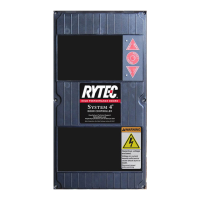INSTALLATION—SYSTEM INPUTS
14
Alternate-Action Activator (Input 4 — N.O. Contact)
Connect the alternate-action activator to the control
panel (terminals 210 and 211) as shown on the sche-
matic that was shipped with the door.
If this input is enabled (momentary contact) with the
door closed, closing, or stopped between the door lim-
its, the door will open. When this input is enabled with
the door open, the door will close. Typical activators tied
to this input include pull cords, push buttons, and radio
controls.
Auto-Close Activator 1 (Input 5 — N.O. Contact)
Connect auto-close activator 1 to the control panel (ter-
minals 210 and 212) as shown on the schematic that
was shipped with the door.
If this input is enabled with the door closed, closing, or
stopped between the door limits, the door will open. The
door will remain open as long as the input is enabled.
Once the input is disabled, the auto-close delay timer
(ACL1) will start. When the timer times out, the door will
automatically close.
An activated timer will automatically reset when the auto
input is enabled. To disable a timer, set the time delay
parameter (P:010) to zero (0) to turn timer off.
Typical activators tied to this input include floor loops
and motion detectors. (This input is exclusive of the
inputs described in “Plug-In Modules” on page 11.)
Auto-Close Activator 2 (Input 6 — N.O. Contact)
Connect auto-close activator 2 to the control panel (ter-
minals 230 and 233) as shown on the schematic that
was shipped with the door.
If this input is enabled with the door closed, closing, or
stopped between the door limits, the door will open. The
door will remain open as long as the input is enabled.
Once the input is disabled, the auto-close delay timer
(ACL2) will start. When the timer times out, the door will
automatically close.
An activated timer will automatically reset when the auto
input is enabled. To disable a timer, set its time delay
parameter to zero (0) seconds. Parameter P:015 = 0 to
turn timer off.
Typical activators tied to this input include floor loops
and motion detectors. (This input is exclusive of the
inputs described in “Plug-In Modules” on page 11.)
Open (Input 8 — N.O. Contact)
Connect the open input to the control panel (terminals
200 and 201) as shown on the schematic that was
shipped with the door.
If this input is enabled (momentary contact) with the
door closed, closing, or stopped between the door lim-
its, the door will open. This input is ignored while the
door is opening.
Close (Input 9 — N.O. Contact)
Connect the close input to the control panel (terminals
200 and 202) as shown on the schematic that was
shipped with the door.
If this input is enabled (momentary contact), the door
will close if the door is open or stopped. This input is
disabled when the door is closing and ignored if the door
is closed or opening.
Stop (Input 10 — N.C. Contact)
Input 10 is equipped with a factory-installed jumper.
Refer to door-specific electrical schematics for informa-
tion regarding this connection.
Programmable
(Inputs 11 and 12 — N.O. or N.C. Contact)
Programmable inputs (if used) are connected to the
control panel (terminals 290 and 291 or terminals 290
and 292) as shown on the schematic that was shipped
with the door.
These inputs can be assigned various functions such as
a third set of photo eyes or an air lock activator.

